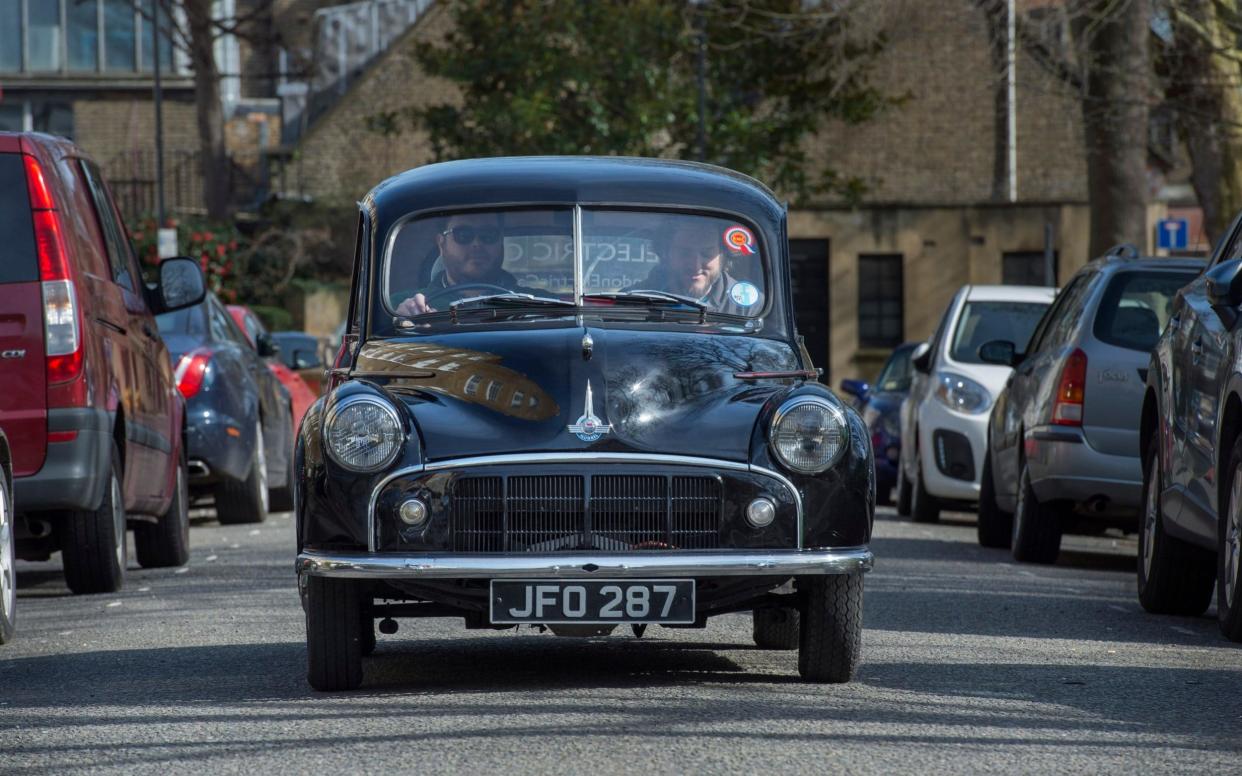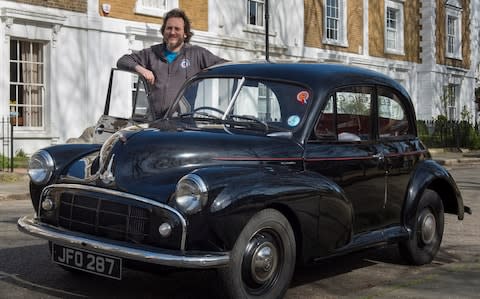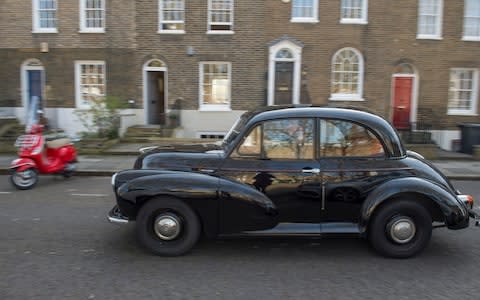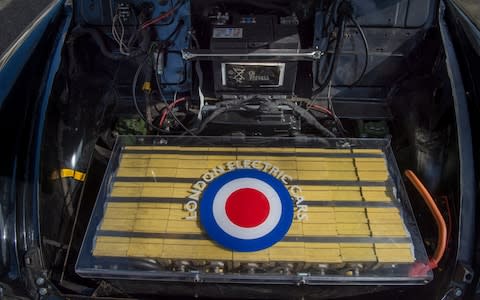A prelude to e-Minor – how this prototype electric Morris might change the world

The car industry has been a little boring of late. Perhaps its the relentless slew of bombastic press releases, with their spittle-flecked enthusiasm and manufactured hype. Maybe it's the lack of truly exciting design, and the increasingly congruous appearance of mainstream cars. Or it could be the unwavering sense that the automobile is dying, and that the things we love – so firmly rooted in the 20th Century – will be historical artefacts by the turn of the 22nd. It's easy to feel a little disheartened by it all.
This mood lasted precisely one morning. Because at 12 noon I phoned a man called Matthew Quitter, who runs London Electric Cars, for a scheduled interview that truthfully sounded pretty dull on paper. And a few hours later I met him in a car park in Lambeth, where he set about reaffirming my love for the motor car and rebuilding my faith in its future.
Matthew has taken a 1953 Morris Minor and replaced its petrol engine with an electric motor. In doing so he has built a zero-emission EV without having to manufacture a whole new car, has improved a pretty classic to make it compatible with modern life, and demonstrated a principle that could be scaled in a meaningful way. It sounds so obvious – turn a dirty fossil fuel vehicle into a clean EV – but I've never encountered one converted so effectively or sympathetically.
It’s charmingly straightforward. Unlike a modern electric powertrain, which often involves several motors dotted around the car, this Morris has undergone a simple transplant. A 30bhp AC unit and nine second-hand ‘Thundersky’ prismatic lithium ion cells occupy the engine bay, while a further 16 such cells replace the fuel tank in the back. A DC-DC converter keeps the lead acid battery happy – the 12v electrics, and all the mechanicals, remain.

That includes the four-speed manual transmission. This is the first electric car I’ve driven that has a clutch pedal, and one of the few in the world that rewards a downshift into a corner. It feels like a Morris, it looks like a Morris, but it pulls away like a first-generation Leaf. It’s an impossibly cheerful vehicle and I’m immediately smitten.
“We’ve looked at direct drive but chose to go via the gearbox for the Morris Minor,” explains Matthew. “The engineering is simpler, and you can use a smaller, cheaper motor, then use the gears to get some more performance out of it. And you keep the feel and originality of the car.”
In terms of horsepower, that inexpensive motor is comparable to the 803cc A-series engine originally fitted to Minors. But the torque has more than doubled to 100lb ft, which makes it possible to drive the electric Morris like an automatic. Second gear will fulfil nearly all urban duties, though fourth – straight-through – is helpful on faster stretches.
Once you’ve done the conversion, the Minor costs around a pound a week to run.
This is fundamentally a city car. “Our target market is London,” says Matthew. “Once you’ve done the conversion, the Minor costs around a pound a week to run. You’re not paying congestion charge, road tax. You’re motoring for £50 a year, which is appealing.”
Even more so are its winsome dynamic ways. I love the elasticity in the steering, the softness of the suspension, the inconsistency of the body roll and the unwavering eagerness of the little motor. I love the minimalism of the car’s design, its thin panels the antithesis of any modern EV's heft. And I love its tiny footprint, which is better suited to London’s streets than anything built this century.
But most of all I love the noise. Stripped of the four-cylinder clatter of an original Morris motor, the electric Minor is a magnificent thing to sit in at speed. The driver hears every creak and bang from the 65-year-old machine; the groan of the steering as I pitch a little too enthusiastically into a turn, the disgruntled thud of the bump stops as I do the same to a speed bump. The whine from the gearbox disappears once fourth is engaged and you’re free to fly along in near-silence, hearing only those sounds emanating from the 65-year-old fuselage. It’s classic motoring laid bare.

You’d be forgiven for assuming that London Electric Cars is in the business of, well, selling electric cars. And if they had a showroom full of electrified British classics like this one I’m sure they’d be very successful. But the objective has always been to create kits that people can use to convert cars at home, giving this project a truly green backbone, as well as global appeal.
“We can only convert a car that people have brought to us, but we can send kits all over the world,” Matthew says. “The Morris Minor kit is the furthest in development and we’ve had interest in that from anywhere the Morris Minor went – India, Australia, New Zealand, America, and Sri Lanka as well, where they still make the parts.”
I do love the Morris Minor and would love an electric Series II, or ideally a Traveller. But I’m conscious of the fact that they feel very old, and that they lack modern niceties such seatbelts. The brakes have been upgraded and there’s now a Bluetooth-enabled stereo hidden somewhere in the dashboard but it’s still outdated, delivering an experience far cruder than what we’ve become used to. But Matthew says the technology will work with far newer cars, which I suspect is where the environmental gains are to be made.

“There are a billion cars in the world at the moment and most people are slowly beginning to realise that petrol and diesel are on their way out, destined to be niche items,” he says. “What are we gonna do with those billion cars? Most are pretty decent, the chassis is strong, the suspension is good – all that’s wrong is the petrol or diesel engine.
“It’s a no-brainer, these cars should all be converted. But the reality is that the car industry is geared up to sell cars.”
He’s right. Keeping an older car on the road is invariably better for the planet than scrapping it and buying a new one. And while new electric cars are undoubtedly cleaner than their fossil fuel counterparts at the tailpipe, manufacturing still accounts for a majority of their environmental footprint – an inconvenient truth that car manufacturers are keen to ignore.
The reality is that the car industry is geared up to sell cars
Aside from the clear environmental and economic benefits, I'm also quite taken by the visual charm of the Minor. It's a rejection of the aesthetic homogeneity of modern car design, and a welcome sight on roads normally dominated by ungainly Japanese and German monoliths. I almost laughed when I saw a Prius alongside the e-Minor; it would be funny if it wasn't so sad.
So Matthew has invented a kit that will cheaply convert fossil fuel cars, old and new, into zero-emission electric vehicles ready for the clean streets of London. The equipment’s performance compares favourably with brand new models, but the charm and character of the original car remains. And while the kit might take a weekend to install, it requires no cutting or welding, and can be completely reversed if necessary. What’s the catch?
“The biggest downside is the up-front cost,” concedes Matthew. “And the next-biggest is charging times.”

At around £3,000 for a viable Morris Minor and £10,000 for the conversion, this isn’t yet a cheap route into electric motoring. You can buy a used Renault Zoe for around half that overall investment, and you’ll get a safer and more reliable machine. But if the OLEV grant applied to conversions, or indeed if a future government scrappage scheme incentivised retro-fitting rather than buying brand new cars, that cost could plummet.
And it takes six hours to fully charge, which will give a range of forty-something miles. “It’s more a mindset thing than anything,” says Matthew. “We’re used to these vehicles that we can drive 600 miles in a single go – fossil fuel cars can do massive journeys without us even thinking about it. But that will slowly evaporate from people’s consciousness.”
I’m not sure how readily Britain will relinquish the convenience of internal combustion. But I know that Londoners use their cars for infrequent, short trips, and if any of these were undertaken in something as delightful as Matthew’s electric Morris then the city would be a far, far nicer place.
Matthew will be at the Classic Car Boot Sale, the free mini-festival of historic cars and vintage clothing, which takes place next weekend (April 28 and 29) at Granary Square, Kings Cross.
For tips and advice, visit our Advice section, or sign up to our newsletter here

 Yahoo News
Yahoo News 
